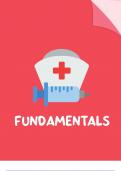FUNDAMENTALS
, FUNDAMENTALS
LEGAL LAWS
TORT: Person injured due to another person’s unintentional CRIME: Intentional wrong doing against another person,
or intentional failure to act. Injury can be physical, people, or environment. Considered both
emotional, or financial. felony & misdemeanor.
Unintentional tort: negligence > Felony: serious crime > insurance fraud,
- Negligence: person harmed due to neglected practicing w/o license, theft of narcotics, etc.
duties, procedures, or precautions. > Misdemeanor: not serious as felony, but still a
+ FAILURE TO: follow standard protocols; report crime > possession of controlled substances, etc.
equipment malfunctions; give standards of
safe care; prevent injuries; question physician’s LIABILITY: Deliberate “commission” of a forbidden
incorrect orders; AND performing procedures act or “omission” of an act required by law.
you were NOT taught. - “act of commission” > participating in illegal
- Malpractice (Professional Negligence): improper abortion, giving person wrong med & is harmed,
or injurious treatment from a licensed person’s etc.
actions or lack of actions. - “act of omission” > person not given
scheduled med & is harmed, failure to report elder
Intentional tort: assault, battery, false or child abuse, etc.
imprisonment, etc.
- Assault: threat or attempt to do bodily
harm > telling elder his/she will take a shower
even if he/she refused.
- Battery: physically touching someone or his/her
possessions w/o consent > beating person,
caring out procedures the person refused,
forcing person out of bed, etc.
Quasi-Intentional: ETHNICAL PRINCIPALS
- Libel: written statement or photo that is false
of damaging.
- Slander: malicious verbal statements that are
false or injurious > gossip & exaggeration. - Advocacy: supports a person’s health, wellness, safety,
- Defamation: act that harms a person’s reputation. privacy, and personal rights.
- Responsibility: respect obligations and follow through
on promises.
- Accountability: willingly taking responsibility for one’s
own actions.
CLIENT RIGHTS - Confidentiality: protection of a person’s privacy.
- Autonomy: a person’s right to make own decision.
- Beneficence: act of kindness and doing good for others.
- Fidelity: keeps promises and fulfills them.
- 1972 A Patient’s Bill of Rights adopted by AHA.
- Justice: fair treatment of giving safe and quality care to
- Client’s rights must be respected and NURSES are
each individual.
responsible for protecting the rights of the client. - Non-maleficence: commitment to do no harm.
- Client has the right to details of procedures, informed - Veracity: commitment to telling the truth.
consent, advance directives, & confidentiality of
information
- Client has the right to REFUSE/DISCONT INUE
treatment/medication/etc. (whether admission is
voluntary or involuntary)
- Client has the right to be active in decision-making
of care plan, accept/refuse/modify care plan, receive
competent care & respect. 42
, FUNDAMENTALS
INFORMED CONSENT HIPAA
- Legal documentation of pt.’s approval to perform - 1996 Health Insurance Portability and
tests, treatments, surgeries, or give certain meds or Accountability Act.
blood products. - Protects pt. info to remain private. Pt. has the
- Pt. must be 18 or older, competent, & verbal. RIGHT to privacy.
- Parent, guardian or advance directive signs consent - DO NOT give pt. info to family or friends w/o
if pt. is a minor, unconscious, unable to communicate, the pt.’s consent.
or mentally disabled. - Keep info within staff members who are
- Emancipation minors are LEGALLY capable of signing directly involved in pt.’s care (HCP, nurse, can,
an informed consent. therapist, dietician, social worker, etc.)
In a life or death situation, two physicians can sign - DO NOT leave papers out in the open.
emergency consent if pt.’s family is NOT immediately Have them face-down.
located (some facilities allow this). - Secure pt. info on computer screen from others.
- Non-consensual physical contact can be required ALWAYS log off before leaving computer.
if pt. is mentally ill, intoxicated, or endangering self or - Wait for pt.’s visitors to leave before discussing
others’ safety. pt.’s info (unless pt. gives consent to discuss
- Only the Physician MUST detail and explain the purpose with visitor(s) in the room).
of procedure, explain benefits & risks, & give options for - ALWAYS close the door when discussing
alternative treatments. private matters.
- Nurse MUST witness pt. sign consent and makes sure - DO NOT discuss pt. info w/ other health
the patient understands what was said. professionals during break, lunch, or outside
- If does NOT understand, inform the physician & of workplace.
the physician is responsible to re-explain & answer
questions about the procedure.
- ALL T EACHING MUST BE DOCUMENT ED.
Students DO NOT obtain or witness consent forms
MASLOW’S
HIERARCHY
ABC’s (AIRWAY, BREATHING, CIRCULATION) SELF-
ACTUALIZATION OF NEEDS
“reach for his/her
highest potential”
Oxygen is one of the most essential of all basic survival
needs. Without oxygen circulating in the bloodstream, a person
SELF ESTEEM
will die in a matter of minutes. Oxygen is provided to the cells
Self image, Self respect,
by maintaining an open airway and adequate circulation. Perception of self-adequacy
ABC is essential for survival
LOVE, AFFECTION, & BELONGING
Airway: determine whether airway is patent (open) or not. Social needs & Spiritual needs
Remove anything that obstructs the airway whether it's food,
blood, vomit, or the tongue falling back (common in unconscious
SECURITY & SAFETY
person).
Freedom from harm (abuse), Healthcare, Shelter
Breathing: listen to breath sounds, watching for chest
movements, & lay your cheek against person’s chest.
Circulation: The heart must pump effectively for oxygen to be BASIC PHYSIOLOGICAL
carried to the cells. Also, there must be sufficient blood volume Oxygen, Water, Food, Elimination, Sleep, Exercise, Sexual
Gratification (for the survival of species), and
to carry needed oxygen. Temperature Regulation
Find a pulse, observe the pulse, reassess breathing, & assess
for signs of internal or external bleeding, control
hemorrhage if bleeding does occur.
43




